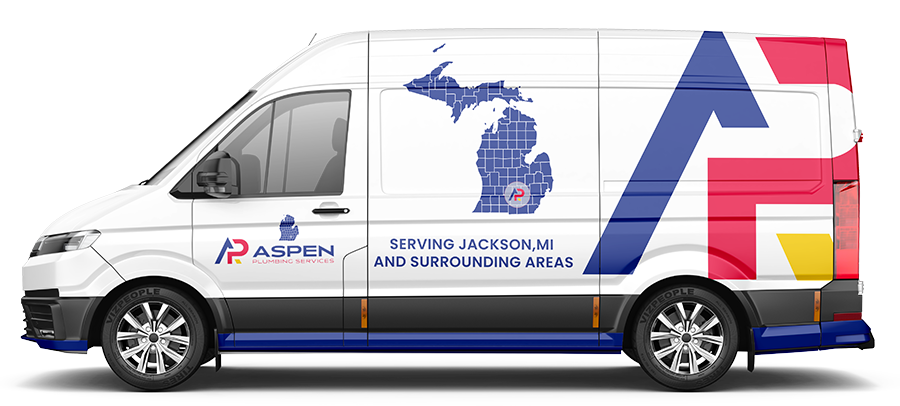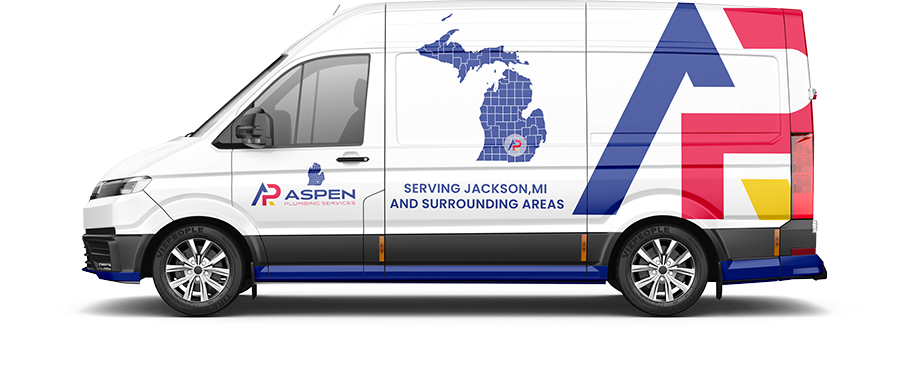Professional Tub & Shower Replacement
Having a clean and comfortable bathtub is a must, especially when you’re looking for a soak after a hard day’s work, so it is essential to select the best type of tub when upgrading or renovating your bathroom. Whether you’re looking to add a bathtub or upgrade an existing one, the technicians at Aspen Plumbing Services are your local experts. Call today for your appointment!

Tub Replacement Information Center
When it comes to showers and tubs, our team of highly skilled and trained plumbing experts have years of experience and can provide you with all of the information that you need regarding your bathtubs, showers, etc. Below you will find helpful information, but feel free to call our team any time with any questions or concerns that you may have!
What are the Different Kinds of Bathtubs?
There are several types of bathtubs, each designed to cater to different preferences, bathroom layouts, and functional needs. When choosing a bathtub, it’s important to consider factors such as space, aesthetic, budget, and the type of bathing experience you want. Below are the most common types of bathtubs:
1. Freestanding Bathtubs
A freestanding bathtub is not attached to any walls or surrounding fixtures, giving it a luxurious and independent appearance. These tubs come in various shapes, including oval, rectangular, and even more unique forms. They are often placed in the center of the bathroom as a focal point, ideal for spacious bathrooms.
Advantages: Elegant design, versatile placement, easy to install (no need for surround walls).
Materials: Available in acrylic, cast iron, stone resin, and copper.
Ideal For: Large bathrooms, modern or classic decor.
2. Alcove Bathtubs
An alcove bathtub is a bathtub that is built into three sides of the bathroom, typically with walls on either side and a showerhead installed above. This is one of the most common types of bathtubs and is often used in more compact or standard-sized bathrooms.
Advantages: Space-efficient, good for smaller bathrooms, cost-effective, easy to install.
Materials: Acrylic, fiberglass, and enameled steel.
Ideal For: Small to medium bathrooms, efficient use of space.
3. Drop-In Bathtubs
A drop-in bathtub is designed to be placed inside a pre-built frame or platform, which is typically custom-built into the surrounding area. The tub is dropped into the framework, and the edges of the tub are surrounded by decking or other materials.
Advantages: Customizable look, seamless design, can be integrated with other features like jets or custom surfaces.
Materials: Acrylic, fiberglass, or solid surface materials.
Ideal For: Homeowners seeking a custom look, luxury bathrooms.
4. Corner Bathtubs
As the name suggests, a corner bathtub is designed to fit into a corner of your bathroom, making efficient use of space while still offering a large bathing area. These bathtubs are often rounded or triangular in shape.
Advantages: Space-saving, unique design, often features built-in seating for a relaxing experience.
Materials: Acrylic, fiberglass, and sometimes whirlpool options.
Ideal For: Small to medium bathrooms, maximizing corner spaces.
5. Whirlpool Bathtubs (Jacuzzi)
A whirlpool bathtub, commonly known as a Jacuzzi, includes built-in jets that circulate water to provide a massage-like experience. These tubs are ideal for relaxation and therapeutic purposes.
Advantages: Offers a spa-like experience, helps with muscle relaxation, and provides a luxury feel.
Materials: Acrylic, fiberglass, and sometimes cast iron.
Ideal For: People who want a relaxing, therapeutic bathing experience.
6. Clawfoot Bathtubs
A clawfoot bathtub is a vintage-style freestanding tub supported by four decorative legs, often shaped like claws (though some designs may feature different styles of feet). These tubs have a classic, old-fashioned charm.
Advantages: Timeless aesthetic, offers a unique vintage style, often deeper than standard tubs for a more luxurious experience.
Materials: Typically made from cast iron, but modern versions may also be made from acrylic.
Ideal For: Vintage or retro bathrooms, homeowners seeking a classic look.
7. Walk-In Bathtubs
A walk-in bathtub is designed for accessibility, especially for individuals with limited mobility or the elderly. It features a door that opens to allow you to walk in and out of the tub without stepping over the edge.
Advantages: Safe and accessible for those with mobility issues, includes safety features like grab bars and non-slip surfaces.
Materials: Acrylic or fiberglass.
Ideal For: Elderly or disabled individuals, accessible home design.
8. Soaking Bathtubs
A soaking bathtub is typically deeper and more spacious than a standard bathtub, allowing the bather to fully immerse their body in water for a more relaxing and luxurious bath experience. These tubs often have a more modern or minimalistic design.
Advantages: Deeper than standard tubs, ideal for full-body immersion and relaxation, often feature sleek and contemporary designs.
Materials: Acrylic, stone resin, and cast iron.
Ideal For: Relaxation-focused baths, spacious bathrooms.
9. Japanese Soaking Bathtubs (Ofuro)
A Japanese soaking bathtub (or Ofuro) is a deep, compact tub designed to allow bathers to sit upright and submerge their bodies completely in hot water. Traditionally used for relaxation and stress relief, these tubs often have a minimalist design and are typically found in homes with limited space.
Advantages: Very deep, ideal for a relaxing, full-body soak, often features a compact design perfect for smaller spaces.
Materials: Often made from wood (cypress is traditional), but can also be made from acrylic or stone.
Ideal For: Small bathrooms, relaxation, or those seeking a unique cultural bathing experience.
10. Steam Tubs
A steam bathtub is a combination of a regular bathtub and a steam shower, often equipped with a built-in steam generator. This allows the bather to enjoy a steam bath, which is great for detoxification and relaxation.
Advantages: Combines the benefits of both a bath and a steam room, great for relaxation and skin care.
Materials: Acrylic or other durable, water-resistant materials.
Ideal For: People seeking a multi-functional bathing experience and those who enjoy steam therapy.
11. Air Jet Bathtubs
An air jet bathtub is similar to a whirlpool tub but uses air jets instead of water jets to create a gentle, massaging effect. These tubs often offer a quieter, less intense experience compared to whirlpool tubs, making them ideal for those who prefer a light massage.
Advantages: Quieter than whirlpool tubs, soothing and gentle air jets, more subtle than water-based jets.
Materials: Acrylic and fiberglass.
Ideal For: Those seeking a gentle massage experience or quieter bathing options.
In Conclusion
When choosing a bathtub, it’s essential to consider the size of your bathroom, your budget, and the aesthetic you want to achieve. Whether you prefer the elegance of a freestanding tub, the space-saving design of a corner tub, or the therapeutic benefits of a whirlpool, there’s a bathtub style to fit every need and bathroom layout.
What are Some Things to Consider When Choosing A Bathtub?
When choosing a bathtub, it’s important to think through several factors to ensure that the tub you select meets your needs in terms of functionality, aesthetics, comfort, and budget. Here are some key considerations to help guide your decision:
1. Size and Space
The available space in your bathroom is one of the most important factors when selecting a bathtub. Measure the space where you plan to install the tub to ensure it fits comfortably without overcrowding the room.
Bathroom Size: For smaller bathrooms, you may want to choose a compact bathtub, such as a corner or alcove tub. Larger bathrooms may allow for more luxurious options, like a freestanding or soaking tub.
Tub Dimensions: Bathtubs come in various sizes, so be sure to pick one that accommodates your family or your personal preferences for space. If multiple people will be using the tub, a larger model might be more appropriate.
2. Type of Tub
There are different types of bathtubs designed for different purposes. Consider what kind of bathing experience you prefer and how you plan to use the tub:
Freestanding Tubs: Ideal for larger bathrooms and homeowners looking for a stylish, luxurious look.
Alcove Tubs: Perfect for smaller bathrooms where space is limited, and you want to maximize usability without compromising on function.
Whirlpool or Air-Jet Tubs: Great for relaxation and therapeutic purposes, providing a soothing, massaging effect.
Walk-In Tubs: Best for those with limited mobility, as they offer easy access and are designed for safety.
3. Material
Bathtubs are made from a variety of materials, each with its advantages and drawbacks:
Acrylic: Lightweight, affordable, and easy to maintain. It’s available in a wide range of shapes and sizes.
Fiberglass: Another budget-friendly option, fiberglass is durable and lightweight but can be prone to scratching over time.
Cast Iron: Known for its durability and excellent heat retention, cast iron tubs are heavy and often more expensive.
Stone Resin: Offers a modern, sleek look and is durable. These tubs can be quite heavy but are usually very luxurious.
Copper: Adds a unique, rustic aesthetic, but tends to be pricier and may require more maintenance.
4. Style and Aesthetic
The style of the tub can significantly impact the overall design of your bathroom. Consider the look you want to achieve:
Modern vs. Traditional: Some tubs, like freestanding clawfoot tubs, lend themselves to a more traditional or vintage style. If you want a more modern, minimalist bathroom, a clean-lined soaking tub or a sleek drop-in model might be better suited.
Customization: Some tubs, like drop-in models, allow for customization with different materials, tile surrounds, and additional features, enabling a tailored design to complement the overall aesthetic of your bathroom.
5. Comfort and Ergonomics
Comfort is a key factor in choosing a bathtub. You’ll want to ensure that the tub is comfortable enough for prolonged use, whether for relaxation or practical purposes.
Depth: Soaking tubs tend to be deeper than traditional tubs, which may be ideal for those who want to immerse themselves fully in the water.
Shape and Angle: Look for a tub that has a comfortable backrest and a design that allows you to relax in a natural position. Some tubs offer sloped backs, armrests, or built-in seating for added comfort.
Jets or Air Jets: If you’re opting for a whirlpool or air-jet tub, make sure the placement and intensity of the jets meet your relaxation preferences.
6. Installation Requirements
Consider the complexity of installation when selecting a bathtub. Some tubs, like freestanding models, are easier to install and require fewer plumbing modifications, while others, such as built-in alcove or drop-in tubs, may require more effort and adjustments to fit properly into your bathroom layout.
Plumbing Needs: Some tubs, especially those with jets or advanced features, may require specialized plumbing. Check the compatibility with your existing plumbing setup before making a decision.
Space Planning: Ensure that the tub installation allows for easy access to plumbing for maintenance or repairs in the future.
7. Budget
Bathtub prices can vary significantly based on the material, type, and features. While an acrylic or fiberglass tub may be more affordable, a high-end model like a copper tub or a jet tub can be quite expensive.
Affordability: Consider your budget and compare options that provide the features you need within that range.
Long-Term Value: It’s also important to consider the durability and maintenance costs of the tub over time. While a higher-end tub might cost more initially, it may be more cost-effective in the long run if it requires less maintenance.
8. Energy Efficiency and Water Usage
If you’re conscious about water conservation or energy usage, look for a bathtub that uses water efficiently. Larger tubs, such as soaking tubs, typically require more water to fill, whereas smaller tubs may use less. For energy efficiency, especially if you’re choosing a heated tub, consider how much energy is required to maintain a comfortable temperature.
Water-Saving Features: Some modern tubs are designed to be more efficient with water, which can help lower your water bills over time.
Heated Tubs: If you’re interested in heated tubs, keep in mind that they may have an impact on your energy usage.
9. Maintenance and Durability
Choosing a bathtub that’s easy to maintain and durable is essential for keeping it in good condition over the long term.
Cleaning: Some materials like acrylic and fiberglass are easier to clean and maintain than others like cast iron or stone. Make sure you’re comfortable with the level of upkeep required for the material you choose.
Scratch Resistance: Look for tubs that resist scratching or staining, especially if you have hard water or expect high usage.
10. Safety Features
For households with children, elderly individuals, or anyone with mobility concerns, it’s essential to consider safety features in your bathtub selection. Look for tubs that provide:
Non-slip Surfaces: Some tubs come with textured bottoms or slip-resistant coatings for added safety.
Grab Bars: These provide extra support when getting in and out of the tub and can be particularly important for elderly or disabled individuals.
Walk-In Features: If safety is a primary concern, a walk-in bathtub with a door is an excellent option for those with limited mobility.
In Conclusion
Choosing the right bathtub depends on factors such as size, type, material, comfort, aesthetic preferences, and budget. Take the time to measure your space, think about the type of bathing experience you want, and assess your home’s plumbing and installation requirements. With the right bathtub, you can enhance both the function and style of your bathroom while creating a relaxing and enjoyable bathing experience.
Why Consider a New Tub?
Aesthetics: Outdated color, surface chipping, stains that won’t come out.
Functionality: Cracks, leaks, or uncomfortable size/shape.
Accessibility/Safety: Need for a walk-in tub or a lower threshold for easier access.
Home Value: Mention how a new tub can increase the bathroom’s appeal and the overall home value.

Why Choose Us?
At Aspen Plumbing Services, we are dedicated to being the trusted plumbing, soft water and drain cleaning and jetting experts, and have been for over 40 years. We serve all of Jackson County and many surrounding areas and our team works hard to ensure our customers get exactly what they need. From using top-of-the-line equipment to making sure our team is well-trained, we strive to provide 5-star service each and every time. Call us today to schedule your service to find out why we have earned a reputation of integrity and quality work.

- In Business Since 1981
- Family Owned & Operated
- Free Estimates On Installations
- Low Interest Financing Available
- Emergency Service
- Available 24/7
- Licensed & Insured
- Performance & Satisfaction Guarantees
Tub Replacement Tips From The Experts
Frequently Asked Questions
What is the Average Lifespan of a New Bathtub?
The lifespan of your new bathtub is heavily dependent on the material you choose and how well it is maintained.
Acrylic Tubs: These are popular and durable, typically lasting 10 to 15 years before showing significant wear. High-quality acrylic can resist fading and chipping well.
Fiberglass Tubs: While the most economical choice, fiberglass is more porous and prone to scratching, usually lasting around 7 to 10 years.
Cast Iron Tubs (Porcelain-Enamel): These are the gold standard for longevity. With excellent care, a cast iron tub can last 50 years or more, making it a fantastic investment in your home’s permanent fixtures.
We only install tubs from trusted manufacturers to ensure you get the maximum lifespan from your investment.
Is a Tub Replacement Messy?
We take every precaution to minimize mess, including laying down drop cloths and ensuring proper ventilation. We guarantee a thorough cleanup once the job is complete!
How Long Does a Standard Tub Replacemen Take?
Typically, a standard, one-for-one tub replacement takes between one to three days, depending on the scope of work (e.g., if we are replacing surrounding tile or simply the tub itself).
Is There a Charge for the Initial Tub Replacement Estimate?
No, we proudly offer completely free, no-obligation estimates for all tub replacement and installation projects.
We understand that replacing a tub is a significant investment, and you need reliable information before committing. Our free estimate includes:
On-Site Assessment: A professional will visit your home to inspect your current bathroom space, take precise measurements, and discuss any potential plumbing or structural considerations.
Product Consultation: We will review your style, material, and budget preferences to recommend the perfect new tub and fixture options for your home.
Detailed Quote: You will receive a comprehensive, itemized quote covering the cost of the new tub, labor, removal and disposal of the old unit, and any necessary plumbing modifications.
This appointment is designed to provide you with all the information you need to make an informed decision, completely free of charge.
Financing
- Low Interest Financing
- 0% Interest For Up To 12 Months
- Get Approved In Minutes

Aspen Plumbing Services

- 4131 W. Michigan Ave. Jackson, MI 49202
- Phone: (517) 750-9913
- Fax: (517) 750-0900
- Available 24/7
Contact Us
"*" indicates required fields


